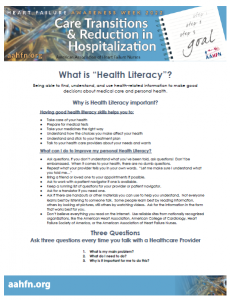The American Association of Heart Failure Nurses Launches “Care Transitions & Reduction in Hospitalization”

AAHFN's Heart Failure Awareness Week 2022 Campaign, "Care Transitions & Reduction in Hospitalization"
AAHFN launches their campaign for Heart Failure Awareness Week 2022, focusing on "Care Transitions & Reduction in Hospitalization"
MT LAUREL TOWNSHIP, NJ, UNITED STATES, February 11, 2022 /EINPresswire.com/ -- The American Association of Heart Failure Nurses (AAHFN) is pleased to announce the theme for Heart Failure Awareness week, “Care Transitions & Reduction in Hospitalization,” this is a week-long campaign centered around raising awareness and developing actionable approaches to ensure all heart failure patients and caregivers have the resources and tools they need to lead a healthy lifestyle.Heart Failure (HF) remains a growing concern in healthcare, with nearly 6.5 million Americans currently living with heart failure and approximately 550,000 new cases diagnosed each year. Heart failure contributes to approximately 287,000 deaths per year and carries a 50% mortality rate within 5 years of diagnosis.(1) This begs the question, what can be done on an individual level when considering different factors you have control of?
Throughout the week, AAHFN will be presenting multiple tip sheets that detail tips and advice on how to handle issues such as anxiety and depression, along with helping you fully understand the concept of being health literate in your everyday life. The goal of these initiatives are to inspire a more heart healthy conscious society in relation to your environment as well as physical and mental care, with the main takeaway being that you are never alone, and to never hesitate to reach out to your health care providers, or loved ones.
Key deliverables for patients include:
Common Heart failure Medications
Heart Failure & Stress
Depression, Anxiety, & Heart Failure
Supporting Care Transitions
Improving Health Literacy
Neighborhood, Environment, & Heart Failure
Heart Failure Readmissions & Common Comorbidities
“AAHFN hopes the tools and information shared during heart failure awareness week, will be something you can use throughout the course of managing your heart failure. We are honored to be on this journey with our patients, families, and all the care providers” AAHFN’s President Linda Wick MSN, CNP, CHFN.
Visit aahfn.org to access all campaign resources for patients, nurses and caregivers to promote heart failure prevention education. For
more information on the 2022 “Care Transitions & Reduction in Hospitalization” campaign, please visit https://www.aahfn.org/hfawarenessweek2022
About Heart Failure
Heart failure, which means the heart does not contract with enough force to pump sufficient blood throughout the body, is a debilitating and life-threatening condition, affecting nearly 6 million Americans.(2,3) It is the leading cause of hospitalization among Americans over the age of 65.(4) Heart failure presents a major and growing health-economic burden that currently exceeds $30 billion in the United States, which accounts for both direct and indirect costs.(2,5)
About the American Association of Heart Failure Nurses (AAHFN)
The AAHFN is a nonprofit specialty organization dedicated to advancing nursing education, clinical practice and research to improve heart failure patient outcomes. The goal of AAHFN is to set the standards for heart failure nursing care. The American Association of Heart Failure Nurses unites professionals, patients and caregivers in the support and advancement of heart failure practice, education and research, thus promoting optimal patient outcomes. AAHFN serves as the interface for sharing ideas, translating research findings into practice and setting priorities for the future. AAHFN focus’ on patients across all environments of care from the hospital, to the clinic, to home.
References
1. Virani SS, Alonso A, Aparicio HJ, et al. Heart Disease and Stroke Statistics- 2021 Update: A Report From the American Heart Association. Circulation.0(0): CIR.0000000000000950.
2. Mozaffarian D, Benjamin EJ, Go AS, et al. Heart Disease and Stroke Statistics—2016 Update: A report from the American Heart Association. Circulation. 2016; 132:000-000. doi: 10.1161/CIR.0000000000000350.
3. Fauci A, Longo D. Disorders of the Heart. Harrison’s ‘Principles of Internal Medicine. 17th ed. New York, NY; McGraw-Hill Book Co; 2008;4:1442-55.
4. Wier LM, Pfuntner A, Maeda J, et al. HCUP Facts and Figures: Statistics on Hospital-based Care in the United States, 2009. Agency for Healthcare Research and Quality. 2011; 1-3.
5. Heidenreich PA, Albert NM, Allen LA, et al. Forecasting the impact of heart failure in the United States: a policy statement from the American Heart Association. Circ Heart Fail. 2013;6:606-619.
Gallagher R, Luttik M-L, Jaarsma T. Social Support and Self-care in Heart Failure. J Card Nurs. 2011; Vol. 26, No. 6, pp 439-445.
Karyn Lockshine
American Association of Heart Failure Nurses
+1 856-793-0806
email us here
Visit us on social media:
Facebook
Twitter
Legal Disclaimer:
EIN Presswire provides this news content "as is" without warranty of any kind. We do not accept any responsibility or liability for the accuracy, content, images, videos, licenses, completeness, legality, or reliability of the information contained in this article. If you have any complaints or copyright issues related to this article, kindly contact the author above.


